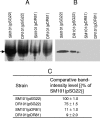Antisense-RNA-mediated decreased synthesis of small, acid-soluble spore proteins leads to decreased resistance of clostridium perfringens spores to moist heat and UV radiation
- PMID: 17259355
- PMCID: PMC1855649
- DOI: 10.1128/AEM.02500-06
Antisense-RNA-mediated decreased synthesis of small, acid-soluble spore proteins leads to decreased resistance of clostridium perfringens spores to moist heat and UV radiation
Abstract
Previous work has suggested that a group of alpha/beta-type small, acid-soluble spore proteins (SASP) is involved in the resistance of Clostridium perfringens spores to moist heat. However, this suggestion is based on the analysis of C. perfringens spores lacking only one of the three genes encoding alpha/beta-type SASP in this organism. We have now used antisense RNA to decrease levels of alpha/beta-type SASP in C. perfringens spores by approximately 90%. These spores had significantly reduced resistance to both moist heat and UV radiation but not to dry heat. These results clearly demonstrate the important role of alpha/beta-type SASP in the resistance of C. perfringens spores.
Figures




Similar articles
-
The small acid-soluble proteins of spore-forming organisms: similarities and differences in function.Anaerobe. 2024 Jun;87:102844. doi: 10.1016/j.anaerobe.2024.102844. Epub 2024 Apr 4. Anaerobe. 2024. PMID: 38582142 Free PMC article. Review.
-
Role of small, acid-soluble spore proteins in the resistance of Clostridium perfringens spores to chemicals.Int J Food Microbiol. 2008 Mar 20;122(3):333-5. doi: 10.1016/j.ijfoodmicro.2007.12.006. Epub 2007 Dec 23. Int J Food Microbiol. 2008. PMID: 18221812
-
Roles of DacB and spm proteins in clostridium perfringens spore resistance to moist heat, chemicals, and UV radiation.Appl Environ Microbiol. 2008 Jun;74(12):3730-8. doi: 10.1128/AEM.00169-08. Epub 2008 Apr 25. Appl Environ Microbiol. 2008. PMID: 18441110 Free PMC article.
-
Effect of a small, acid-soluble spore protein from Clostridium perfringens on the resistance properties of Bacillus subtilis spores.J Bacteriol. 2007 Nov;189(21):7927-31. doi: 10.1128/JB.01179-07. Epub 2007 Aug 31. J Bacteriol. 2007. PMID: 17766414 Free PMC article.
-
Spores of Bacillus subtilis: their resistance to and killing by radiation, heat and chemicals.J Appl Microbiol. 2006 Sep;101(3):514-25. doi: 10.1111/j.1365-2672.2005.02736.x. J Appl Microbiol. 2006. PMID: 16907802 Review.
Cited by
-
The Clostridium perfringens germinant receptor protein GerKC is located in the spore inner membrane and is crucial for spore germination.J Bacteriol. 2013 Nov;195(22):5084-91. doi: 10.1128/JB.00901-13. Epub 2013 Sep 6. J Bacteriol. 2013. PMID: 24013629 Free PMC article.
-
The small acid-soluble proteins of Clostridioides difficile are important for UV resistance and serve as a check point for sporulation.PLoS Pathog. 2021 Sep 8;17(9):e1009516. doi: 10.1371/journal.ppat.1009516. eCollection 2021 Sep. PLoS Pathog. 2021. PMID: 34496003 Free PMC article.
-
The small acid-soluble proteins of spore-forming organisms: similarities and differences in function.Anaerobe. 2024 Jun;87:102844. doi: 10.1016/j.anaerobe.2024.102844. Epub 2024 Apr 4. Anaerobe. 2024. PMID: 38582142 Free PMC article. Review.
-
Clostridium perfringens spore germination: characterization of germinants and their receptors.J Bacteriol. 2008 Feb;190(4):1190-201. doi: 10.1128/JB.01748-07. Epub 2007 Dec 14. J Bacteriol. 2008. PMID: 18083820 Free PMC article.
-
Insights into the Structure and Protein Composition of Moorella thermoacetica Spores Formed at Different Temperatures.Int J Mol Sci. 2022 Jan 4;23(1):550. doi: 10.3390/ijms23010550. Int J Mol Sci. 2022. PMID: 35008975 Free PMC article.
References
-
- Cabrera-Martinez, R. M., J. M. Mason, B. Setlow, W. M. Waites, and P. Setlow. 1989. Purification and amino acid sequence of two small, acid-soluble proteins from Clostridium bifermentans spores. FEMS Microbiol. Lett. 52:139-143. - PubMed
-
- Cabrera-Martinez, R. M., and P. Setlow. 1991. Cloning and nucleotide sequence of three genes coding for small, acid-soluble proteins of Clostridium perfringens spores. FEMS Microbiol. Lett. 61:127-131. - PubMed
-
- Gerhardt, P., and R. E. Marquis. 1989. Spore thermoresistance mechanisms, p. 43-63. In I. Smith, R. Slepecky, and P. Setlow (ed.), Regulation of prokaryotic development. American Society for Microbiology, Washington, DC.
Publication types
MeSH terms
Substances
Grants and funding
LinkOut - more resources
Full Text Sources

